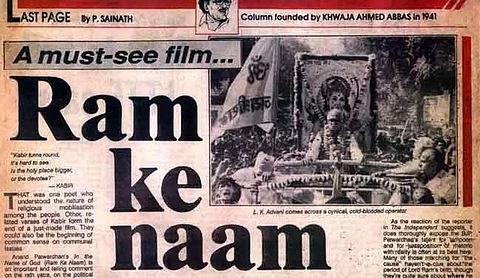
- Home
- न्यूजग्राम
- NewsGram USA
- India
- World
- Politics
- Entertainment
- Culture
- Lifestyle
- Economy
- Sports
- Sp. Coverage
- Misc.
- NewsGram Exclusive
- Jobs / Internships

The eminent director, Anand Patwardhan, records his journey of picturising his most controversial movie, "Ram Ke Naam" (In The Name Of God), in a recent article. Produced in 1992, the movie is one amongst the trilogy of the director describing the "rise of religious fundamentalism". First being "Una Mitra Di Yaad Pyaari/ In Memory Of Friends", second is Ram Ke Naam/ In The Name Of God and the final one is "Pitra, Putra aur Dharmayuddha/Father, Son and Holy War".
the filmmaker Anand Patwardhan
India has long witnessed a communal conflict and the religious sects have never tried to put an end to it. Moreover, the political parties mould the events in ways that would benefit their own agendas. The noted director puts forth the events in his article that paved ways for a long communal riot over the Babri Mosque at Ayodhya. He argues that where on one hand the Hindu community claimed it to be the built at the birthplace of Lord Rama, historians have not found any traces of such a place birth place though they came up with it to be an ancient Buddhist city of Saket.
This whole argument was heated when in 1949 a temple priest, Shastriji, broke out in the Mosque premises and installed an idol of Lord Rama, claiming the Mosque built by Mughal Emperor Babar being a transgressive act. He asserts: "The rationale for this act of destruction and construction was that Babar had supposedly built this mosque after demolishing a temple to Lord Ram that had marked the exact location of Lord Ram's birth." The Director worked in a two-member crew consisting of him and his colleague Pervez who passed away before having a look at the final editing.
the cover for the movie
To answer what could have been the reason of such claim he says: "Today, Ayodhya is full of Ram temples and at least 20 of them claim to be built at the birthplace of Ram. The reason is obvious. Any temple that establishes itself as the birthplace of Ram gets huge donations from its devotees." His film encompasses the Rath Yatra in 1990 when it reached Bombay, but it has a longish context to it.
Bothe the crew members traced the events that took place in the name of constructing a Temple taking over the Mosque. The Muslim-Hindu trajectory turned out to be such that the place where one was majority the other was an oppressed minority. On October 30, 1990, a mob went to Uttar Pradesh in order to attack the Babri Mosque despite of the swearing that Mulayam Singh Yadav provided of not letting even a bird in. The day became exemplum for later days showcasing what all can be seen in proving one's religion as superior. An official count of 29 deaths was recorded; however, later hyperbolas of some leaders reported it reaching to a thousand and the bodies being thrown away into the Saryu River.
a newspaper report during the rath yatra
The filmmaker furthers with his own struggle of telecasting a disputed movie. Even after winning "a national award for Best Investigative Documentary as well as a Filmfare Award for Best documentary", the movie was regarded anti- Indian by some great personalities. He even had to go through a bias at the television broadcasting at Doordarshan, against which he later had to file a case. After 5 years of contest, he finally was able to make it reach to a larger audience but the reputation of the movie didn't let it to be a huge success.
Though the court has settled the dispute now by giving spaces to the Temple, the Mosque and the Akhada. However, this never-ending dispute has not been settled. one has to look into the matter to find an impasse to this. The movie exposes the audience to the reality of the situations.
Megha is a student at the University of Delhi. She is pursuing her Masters in English and has also done her studies in German Language. Twitter: @meghash06510344
